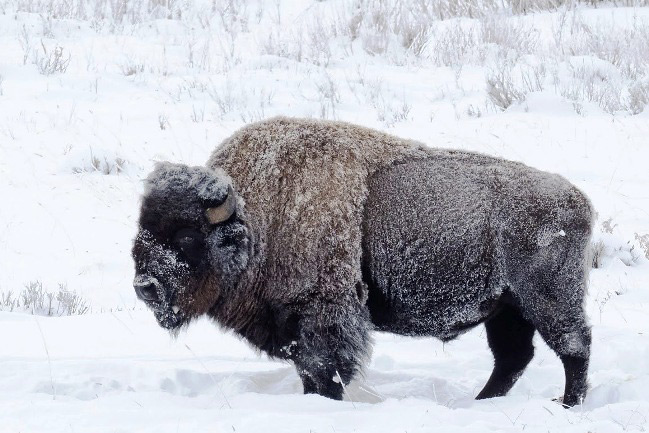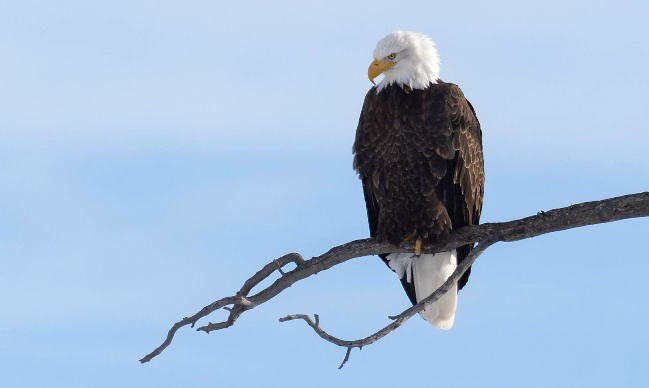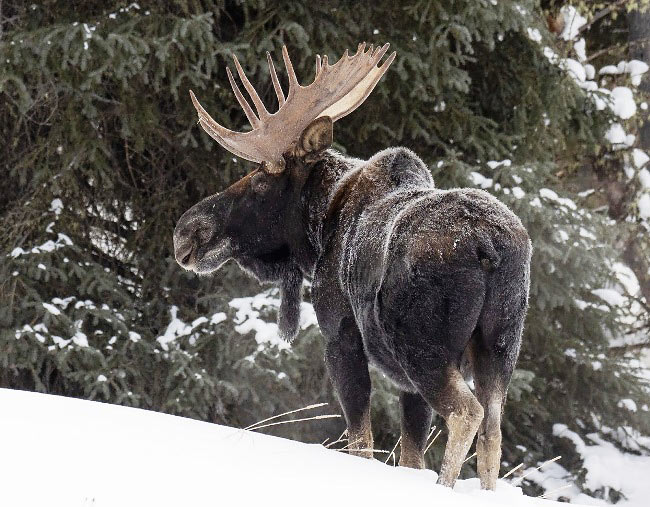

Wolf by Chris Townend.
- One of the richest places for mammals in North America
- Including Wolf, Grizzly and Black Bears, American Bison and Moose
- As well as some of North America's and the world's most spectacular birds including resident Bald Eagles and Clark's Nutcrackers, summering Sandhill Cranes, Mountain Bluebirds and Harlequin Ducks, and wintering Bohemian Waxwings
- All in the superb settings of the Grand Tetons and Yellowstone, complete with snowy mountains, geysers, steam vents, hot springs and bubbling mud pools

American Bison by Simon Colenutt.
- Some organized tours also include the Billings area in nearby Montana in their summer itineraries. A wide variety of waterbirds, as well as landbirds such as Chestnut-collared and McCown's Longspurs, occur there.
- The lists of mammals and birds below are for the northern summer. Wolves are more likely to be seen during the northern winter when only about 50 species of birds are present, but they do include the likes of Trumpeter Swan, Barrow's Goldeneye, Bald and Golden Eagles, Rough-legged Buzzard, Townsend's Solitaire, American Dipper, Bohemian Waxwing, and Black and Grey-crowned Rosy-finches, mostly in the Northern Range, east out of Mammoth Hot Springs.

Bald Eagle by Simon Colenutt.
Best Birds and other wildlife in Wyoming
Mammals
Wolf (reintroduced), Grizzly (Brown) and Black Bears, American
Bison, Moose, Elk, Pronghorn, Mule and White-tailed Deer, Bighorn Sheep, Mountain Goat, Coyote,
Muskrat, Yellow-bellied Marmot, Red Squirrel, Least and Yellow-Pine Chipmunks, and Mountain Cottontail.
Also a chance of Bobcat (along Madison River, especially during the winter), American Beaver and River Otter.
Birds
The birds listed are either resident or northern summer visitors only,
unless otherwise indicated. Bald Eagle, Sandhill Crane, Mountain Bluebird, Clark's Nutcracker, Harlequin Duck
and Bohemian Waxwing (winter), as well as Trumpeter Swan, Barrow's Goldeneye, Ruffed and (Greater) Sage Grouse,
Clark's and Western Grebes, American White Pelican, Golden Eagle, Ferruginous Hawk, Long-billed Curlew, Wilson's
Phalarope, Broad-billed, Calliope and Rufous Hummingbirds, Belted Kingfisher, Red-naped and Williamson's Sapsuckers,
Grey, Pinyon and Steller's Jays, Red-breasted Nuthatch, American Dipper, Townsend's Solitaire, MacGillivray's Warbler,
Western Tanager, Lazuli Bunting, Black and Grey-crowned Rosy-finches, and Yellow-headed Blackbird. Also a chance of
Great Grey Owl, Blue (Dusky) Grouse, Prairie Falcon, Lewis's Woodpecker and Pine Grosbeak.

Moose by Simon Colenutt.
Other Natural Wonders of Wyoming
Yellowstone NP This National Park contains the largest and most varied collection of geothermal phenomena in the world, including hot springs, steaming terraced pools, bubbling mud pools and geysers, the most famous of which, 'Old Faithful', spouts on average every 72 minutes, day after day, year after year, for two to five minutes, usually to 40 m (130 ft) but sometimes as high as 60 m (197 ft). Also present in the park are petrified forests of trees buried alive in volcanic ash, and an impressive canyon 39 km (24 miles) long, an average 300 m (1000 ft) wide and up to 365 m (1200 ft) deep.
Grand Teton NP The small but dramatic range of snowy mountains known as the Grand Tetons, the highest of which gives this National Park its name, rises abruptly from the west side of a broad valley known as Jackson Hole, more than 2000 m (6600 ft) above the valley floor in places, to 4197 m (13,770 ft) above sea level.
Best Sites for Birds and other wildlife in Wyoming
- National Elk Refuge Sandhill Crane. Also a chance of Ferruginous Hawk.
- Grand Teton NP Bald Eagle, Mountain Bluebird, Clark's Nutcracker, Calliope Hummingbird, Western Tanager and Black Rosy-finch. Also a chance of Moose, American Beaver and Great Grey Owl.
- Yellowstone NP Wolf, Grizzly (especially along the Yellowstone River in Hayden Valley) and Black Bears, American Bison, Moose, Elk, Pronghorn, Bighorn Sheep (especially in the Tower area), Mountain Goat (especially from the parking areas at Baronette Peak, Pebble Creek and Trout Lake), Bald Eagle, Sandhill Crane, Mountain Bluebird, Clark's Nutcracker, Harlequin Duck, Ferruginous Hawk, Bohemian Waxwing, Western Tanager and Lazuli Bunting. Also a chance of Great Grey Owl, Blue (Dusky) Grouse, Prairie Falcon, Lewis's Woodpecker and Pine Grosbeak.
- Beartooth Pass Yellow-bellied Marmot, Clark's Nutcracker, Black and Grey-crowned Rosy-finches. Also a chance of Pine Grosbeak.
Best Times for Birds and other wildlife in Wyoming
Mid-January to the end of March in the northern winter or June in the northern summer are the best times to look for birds and most mammals. The geothermal phenomena are more pronounced during the very cold and snowy northern winters, when Wolves are more likely to be seen, especially during February which is when they usually raise their young and therefore wander more widely, although there is also a good chance in April-May and September-October, always especially in the Lamar Valley, Yellowstone (although sightings here are not as reliable as they once were). There is less chance of seeing Wolves during the summer when they roam higher up the mountain slopes. American Bison usually rut in the first half of August and Elk in the second half of September, which is also a good time to see the autumn (fall) colours. Yellowstone NP in particular is often crammed full of tourists during the summer, particularly in July and August, but it is much less crowded during the winter when temperatures can fall to as low as -40°F.
Recommended Bird Books etc. for Wyoming
Yellowstone and Grand Teton National Parks by B Mayhew and C McCarthy. Lonely Planet, 2008 (Second Edition).
The Rough Guide to Yellowstone and Grand Teton by S Timblin. Rough Guides, 2007.
Mammals of North America by R W Kays and D E Wilson. PUP, 2009 (Second Edition).
Mammals of North America by F A Reid. Peterson North American Field Guides, 2006. (Fourth Edition).
Peterson Field Guide to Finding Mammals in North America by V Dinets. Houghton Mifflin, 2015.
Field Guide to the Birds of North America edited by J Dunn and J Alderfer. NGS, 2017 (Seventh Edition).
Kaufman Field Guide to Birds of North America by K Kaufman. Houghton Mifflin, 2005.
The North American Bird Guide by D Sibley. Helm, 2014 (Second Edition).
Kaufman Field Guide to Butterflies of North America by J Brock and K Kaufman. Houghton Mifflin, 2003.
Apps etc.
National Geographic Birds: Field Guide to North America.
The Sibley eGuide to the Birds of North America.
Peterson Birds of North America.
Audubon Birds - A Field Guide to North American Birds.
iBird Ultimate Guide to Birds.
Birding and Wildlife Trip Reports for Wyoming
Many trip reports, some for Wyoming, are posted on the websites listed here. On some of these websites some reports are independent and some are posted by tour companies who organize tours to Wyoming. These tour companies and others also post their own reports on their websites, which are listed under 'Some Organized Tours to Wyoming' below.
- The best website for trip reports is CloudBirders
- but these are also worth a look
- Birdtours
- Fatbirder
- Jon Hornbuckle
- Mammal Watching
Local bird and wildlife guides in Wyoming
The costs of organized tours partly reflect the quality of the tour leaders. Some leaders are certainly better than others and many companies claim their leaders are the best but even the best rely at least to some extent on the exceptional skills of the local guides they employ. If you are travelling independently, employing such local guides will greatly increase your chances of seeing the wildlife you wish to see.
Accommodation for birders in Wyoming
Some Organized Tours for birds and other wildlife to Wyoming
There are many tour companies who organize tours to see mammals, birds, other wildlife and other natural wonders. The cost of these tours vary considerably according to such variables as the airlines used, the number of days the tours last, the number of sites visited, the number of people in the group (an important consideration if you wish to see such wildlife as rainforest mammals and birds), the number of tour leaders, the standard of accommodation and transport, and the percentage profit the company hopes to make. Generally, where the number of days tours last and the number of sites visited are similar, the cheapest tours are those that use the cheapest airlines, accommodation and local transport, that have the largest groups with the least number of leaders, and that make the least amount of profit. The most expensive tours tend to be those which are exceptionally long, use the most expensive accommodation (ridiculously lavish in some cases, even for single nights) and which make the most profit. Some tour costs partly reflect the quality of the tour leaders. Some leaders are certainly better than others and many companies claim their leaders are the best but even the best rely at least to some extent on the exceptional skills of the local guides they employ.
While tour companies organize tours with set itineraries many also organize custom tours for individuals and private groups who instead of taking a tour with a set itinerary want to follow their own itinerary to suit their own personal tastes, whether it be mammals, birds, other wildlife, other natural wonders or even man-made attractions, or a mixture of them all. Many organized tours with set itineraries are also fast-paced and target as many species as possible, whether they are mammals, birds or other wildlife or everything, which usually leaves little time to enjoy the best sites and individual species, but on a custom tour those taking part can specify the pace and the sites and species they wish to concentrate on. Custom tours also suit people who like to travel with people they already know, rather than with a group of strangers, and people with partners with different interests. Individuals and small groups will almost certainly have to pay more than the price of an organized tour with a set itinerary but a large group of friends may be able to travel for less than the price quoted for a set tour.
Tour companies who run organized tours or can arrange custom tours to Wyoming include the following.
